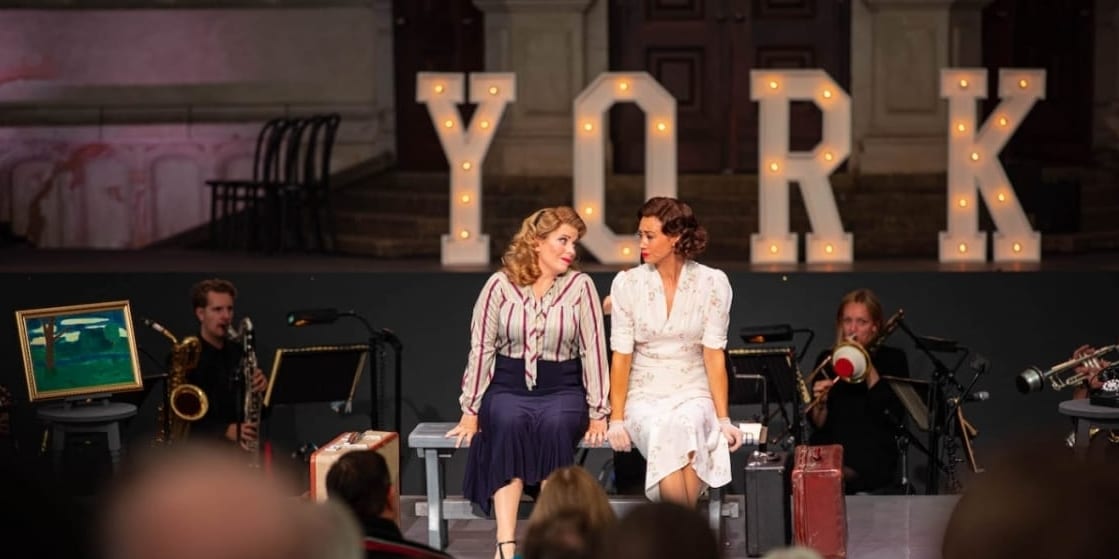‘Quick Fantastic’ lifted spirits last summer with their production of ‘A Little Night Music’, and they did so again with their revival of Bernstein’s ‘Wonderful Town’, which all-too-briefly resides at Opera Holland Park.
Despite the familiarity of the film version and many professional recordings this wonderful score from the peak of Bernstein’s Broadway years has not received many productions in this country. Yet it is well worth its revival given that there is not a dud number in either Act. It offers a rich blend of solo and ensemble numbers of great variety, with ample scope for dynamic choreography, and sustained comic action riffing off a witty script, all supported with brilliant orchestral textures.
The plot, based on semi-autobiographical stories by Ruth McKenny, presents two sisters
from Ohio arriving and encountering New York City for the first time. Ruth is a smart and
sassy wannabe writer, and her sister Eileen is a pretty, socially confident singer. Once
established in a wretched basement apartment in Greenwich Village, the action follows
their search for work and their increasingly madcap encounters with neighbours and
possible employers and lovers. Ultimately work and love sort themselves out with some
important life lessons along the way.
Today’s audiences are likely to have some hesitations about the gender stereotyping
embedded in the action and dialogue; but if the piece is played with conviction and energy
as it is here there is no reason why it should not succeed. Not only do all the best songs and
comic moments belong to the two female leads anyway; but also some of the songs eg.
‘One Hundred Easy Ways to Lose a Man’ satirise and subvert the way women must suppress
their abilities and talents to feed male expectations.
The leads are the key to success in this show and in Louise Dearman (Ruth) and Siubhan
Harrison (Eileen) the production has a winning combination. Physically and vocally
contrasted, they combine a wonderful range of vocal, acting and dancing skills that allow
them to inhabit the several taxing numbers that are entrusted to them. In several others – the famous Latin ‘Conga’ that ends Act 1, the Irish reel ‘My Darlin’ Eileen’, the parody scat sequence ‘Swing’, and the culminating ‘Wrong Note Rag’ – they have to lead a big ensemble number. Here the teamwork is effortlessly inventive, energetic, and technically assured from all involved. The male supporting roles are all well taken, with particularly fine singing from Ako Mitchell as the patient and long-suffering editor Bob Baker, and Roger Dipper as prissy store manager Frank Lippencott.
This is a production in some ways where less is more. The constraints of Covid have necessitated very limited staging. A walkway is constructed around the orchestra, and ‘NEW YORK CITY’ is spelled out in illuminated lights, but bar a few bits of furniture that is the limit of staging. Such is the sharp and snappy work of choreographer Carrie-Anne Ingrouille and director Alistair Knights that you get the full feel and buzz of Manhattan without having to see it. There is always something intriguing and interesting to look at, across the spread of the stage, and Edoardo Lelli’s costumes also give a proper period feel, with a light touch. Jason Carr’s orchestration reduces the score to nine players, heavily relying on woodwind
and brass. This bold and raw sound suits the pulsing energy of the musical and brings out the Latin and jazz inflections very well especially in the virtuosic, sometimes haunting trumpet parts. Alex Parker’s conducting has the pace and bite for the show-stopping, foot-tapping numbers while also finding graceful repose in the gentler songs ‘A Quiet Girl’ and
‘It’s Love’, which are the emotional turning points in the action.
A longer residency in Holland Park would probably have ironed out some issues of balance. At a few points the orchestra was over-amplified in comparison with the singers, thus masking the words in some of the sequences of rapid-fire delivery. In fact, it might have been wise to have all the solo items delivered from in front of the orchestra rather than
starting more remotely up-stage and progressing to the front. These are only minor blemishes, though.
At a time when we all crave uncomplicated, stylish, and tuneful fun this show ticks all the right boxes.

